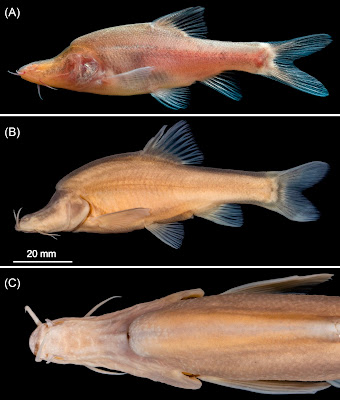 |
| Sinocyclocheilus wanlanensis Liu, Mao & Yang, in Liu, Mao, Sudasinghe, Chen, Yang et Meegaskumbura, 2025 |
Simple Summary
The karst caves of southwest China are home to an extraordinary diversity of cavefish, especially those in the Sinocyclocheilus group, the largest cavefish genus in the world. Using a combination of morphology and genetic analyses, we describe a new species, Sinocyclocheilus wanlanensis, found in an underground river in Guizhou Province. This fish is eyeless or degenerate-eyed, has no horn-like structures on its head (unlike some of its relatives), and features a large hump behind the head and a snout shaped like a duck’s bill. Measurement and comparison with similar species show that it is distinct morphologically. DNA analysis of two mitochondrial genes places it close to S. bicornutus, a related species; the genetic differences, while small, are consistent with what we observe between known sister species. Sinocyclocheilus wanlanensis is also distinct in appearance: it has degenerated eyes (dark spot) or no eyes (compared to the normal eyes of S. bicornutus); it also lacks the split horn found in S. bicornutus. It can be distinguished from the similar-looking S. zhenfengensis by its eyeless/degenerate-eye condition, shorter facial barbels, and longer pelvic fins. Identifying and describing new species is important for protecting cave life and understanding how species evolve in extreme environments.
Abstract
China’s southwestern karst landscapes support remarkable cavefish diversity, especially within Sinocyclocheilus, the world’s largest cavefish genus. Using integrative taxonomic methods, we describe Sinocyclocheilus wanlanensis sp. nov., found in a subterranean river in Guizhou Province. This species lacks horn-like cranial structures; its eyes are either reduced to a dark spot or absent. It possesses a pronounced nuchal hump and a forward-protruding, duckbill-shaped head. Morphometric analysis of 28 individuals from six species shows clear separation from related taxa. Nano-CT imaging reveals distinct vertebral and cranial features. Phylogenetic analyses of mitochondrial cytb and ND4 genes place S. wanlanensis within the S. angularis group as sister to S. bicornutus, with p-distances of 1.7% (cytb) and 0.7% (ND4), consistent with sister-species patterns within the genus. Sinocyclocheilus wanlanensis is differentiated from S. bicornutus by its eyeless or degenerate-eye condition and lack of bifurcated horns. It differs from S. zhenfengensis, its morphologically closest species, in having degenerate or absent eyes, shorter maxillary barbels, and pelvic fins that reach the anus. The combination of morphological and molecular evidence supports its recognition as a distinct species. Accurate documentation of such endemic and narrowly distributed taxa is important for conservation and for understanding speciation in cave habitats.
Keywords: Sinocyclocheilus; new species; Beipanjiang River; cytochrome b; NADH dehydrogenase subunit 4; integrative taxonomy; cavefish; molecular systematics; mtDNA; China
 |
| Sinocyclocheilus wanlanensis sp. nov., GXU2020000062, holotype, 86.74 mm SL. (A) Live specimen (not holotype); (B) lateral view of head in preserved specimen; (C) dorsal view of preserved specimen. |
Sinocyclocheilus wanlanensis Liu, Mao & Yang, sp. nov.
Diagnosis. Sinocyclocheilus wanlanensis is distinguished from all its congeners by the following combination of characters: absence of horn-like structure; eyes absent or degenerated into dark spots; a distinct nuchal hump; predorsal profile distinctly arched; the tip of the adpressed rostral barbel extending posteriorly not reaching vertical through the anterior margin of the sunken eye or dark spot; tip of the pelvic-fin rays reaching the anus when pelvic-fin rays extended backward; a distinct head shape protruding forward, resembling a duck’s beak; body scaleless; in life, body light golden brown; lateral line pores 41–45; gill rakers well developed, 9 on first gill arch.
Distribution and habitat. Known only from a subterranean river within a cave in the town of Wanlan, Zhenfeng County, Guizhou Province, China. This underground river serves as an important source of drinking and irrigation water for local villagers. They have established large and small pumps to extract water from the cave. The water from this underground river eventually flows into the Beipanjiang River. Sinycyclocheilus wanlanensis occurs in sympatry with several other fish species: Longanalus macrochirous, Pterocryptis anomala, Carassius auratus, and Opsariicthys bidens.
Etymology. The new species’ name, wanlanensis, derives from Wanlan Town, Zhenfeng County, where the type specimens were collected.
Yewei Liu, Tingru Mao, Hiranya Sudasinghe, Rongjiao Chen, Jian Yang and Madhava Meegaskumbura. 2025. Description of A New Eyeless Cavefish Using Integrative Taxonomic Methods—Sinocyclocheilus wanlanensis (Cypriniformes, Cyprinidae), from Guizhou, China. Animals. 15(15), 2216. DOI: doi.org/10.3390/ani15152216 [28 July 2025]
